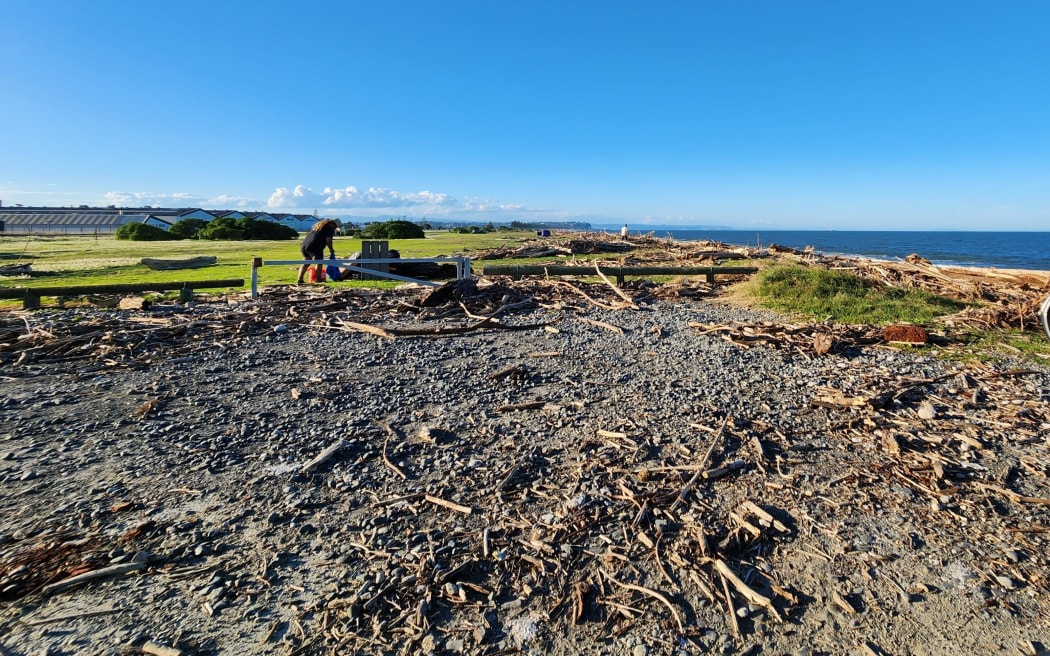
Photo: Emma Ricketts
When Cyclone Gabrielle hit Hawke's Bay in February it flooded homes, devastated communities and destroyed farm infrastructure.
Less visibly, but just as seriously, it also damaged local fisheries.
Commercial fishers have been struggling since, as they navigate logs, fruit and sediment that is scattered across the seabed.
But now, thanks to government recovery funding, NIWA scientists and local fishers are mapping the extent of damage.
Rick Burch is one of those fishermen. He has been operating in Hawke's Bay since 1987.
He's an inshore fisher - meaning he trawls for species like snapper, gurnard and blue cod within 12 nautical miles of the coastline.
This is the first time he has seen a weather event cause so much damage to fisheries.
He says the risks were apparent almost immediately after the cyclone.
"We probably lost about a third of our area in Hawke's Bay for fishing," he said.
"We work very closely together, the fishermen here. A couple of the fishermen who were fishing inside of me, closer to the land, phoned me up and said 'for God's sake Rick, don't come in here, we just picked up a heap of logs'."
Catching logs meant there was less room in the nets for fish - and even worse - the big ones would break equipment.
So the fishermen stayed at least 40 fathoms - or 70 metres - out in the bay, he said.
Vicky Hunt is an adverse event navigator with First Mate; a charity that offers support to commercial fishermen.
They established her role after the cyclone to help those struggling.
The fishermen are still being impacted, she said.
"They are still trawling and catching apples, onions and vegetables. And there are areas where they are avoiding fishing because they know they are going to catch logs in those areas."
That results in increased fuel and operational costs, and because they are not able to fish in their prime locations, they can't catch enough to offset these costs, she adds.
It has been challenging - and according to Burch, there was little support to start with.
"What was going on in the ocean was literally out of sight, out of mind. Other primary industries had help, but we had nothing.
"Then all of a sudden people began to realise we'd lost quite a bit of our fishing area in the bay. Then they realised something had to be done about that."
Funding was made available in May, through the North Island weather events primary industries recovery fund.
It included more than $870,000 for Seafood New Zealand to map hazards on the seafloor - as well as $2.5 million to NIWA to examine the effects on marine habitats.
Seafood New Zealand's funding has been used to support local fishermen, like Burch, locating the sunken logs.
"We've towed about 110 nautical miles. Four days in October, four days in November. We've got a pretty good idea now where the logs are."
But that knowledge was not absolute, he cautioned - it was possible that the tides could move the logs, pushing them into a heap somewhere else.
There was another, potentially longer-term issue.
Silt, which has been carried from the hills via the rivers, is now suspended in parts of the bay.
"What chemicals are in that silt? It went through farmyards, people's garages.
"I think that's going to have a major effect on our fish stocks.
"With Cyclone Bola, the chemicals coming down the rivers killed off the food chain. In a few years’ time here we will see the effects of the loss of that food on the fish and the ecosystem."
NIWA scientists, led by Dr Daniel Leduc, have been examining the affected marine habitats.
Some of the places have accumulated up to one metre of sediment, Leduc said.
"We don't know if they have been directly impacted by the cyclone, but we saw some seafloor ecosystems that don't look in fantastic health."
Attribution was difficult because of the sediment that comes out of rivers anyway, he said.
But suspended sediment that stays around for a long time can be very damaging.
"The light can't get through to the sea floor. So if you've got kelp beds, then they can't grow anymore.
"If the environment in which the fish live isn't healthy, then the fish populations won't be great either."
It was too early to tell what the actual impacts will be, but there was no short-term solution, he said.
Local fishermen will have to wait and see whether how long the sediment sticks around.

